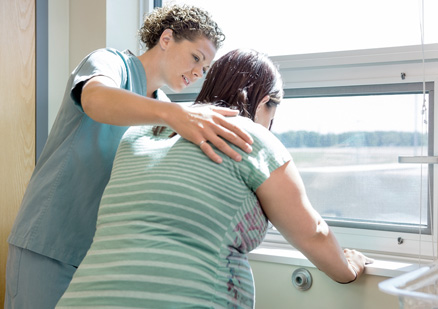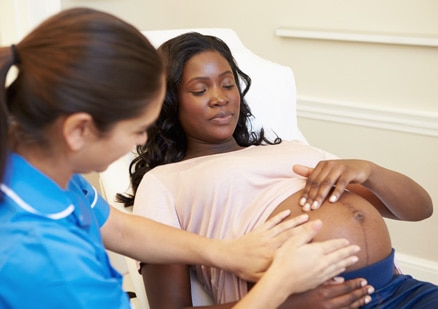Medical help during childbirth

If your labor isn’t progressing as expected, or you or your baby shows signs of distress, we might need to help you deliver. These are some common ways we do that:
Labor coaching
The best way to encourage your baby to come out is with a good labor support person. Our labor and delivery nurses will help, but if you and your partner have been to prenatal classes, you’ll both have these skills too. Once you’re completely dilated, it’s time to start pushing. Listen to the instructions of your nurses and doctors, and they’ll help you deliver your baby safely and as quickly as your baby allows.
Assisted delivery
Sometimes, toward the end, the doctor may offer an assisted delivery if your baby’s in distress or you’ve lost the ability to push well. This means that while you push, the doctor will guide the baby’s head out of the last part of the birth canal. This can be done with forceps, metal tongs, or more commonly a vacuum extract, which is a soft suction cup to hold your baby in place while they’re in the birth canal. We may use this device if your baby starts moving back up into the birth canal during contractions.
Assisted deliveries do have some additional risks. They could cause the baby’s shoulders to get stuck or even cause some bleeding or bruising on their scalp. If the doctor recommends an assisted delivery, it’s because there’s a risk of cesarean birth without it.
Cesarean birth, or C-section
In a cesarean birth, the baby is delivered through an incision that cuts through a parent’s belly and uterus. Sometimes they’re planned before delivery, as is common for babies who are in a breech position. But most C-sections are unplanned, and the decision to perform them is made during delivery because of problems that come up during labor.
At Kaiser Permanente, our goal is to help people who have C-sections have all the same special experiences they imagined they’d have on delivery day. Unless you need an emergency C-section, your partner or support person can be with you. Whenever possible, we’ll talk to you about your preferences — like using drapes in a way that lets you see your baby at delivery, and taking steps to help you and your baby have skin-to-skin contact as soon as possible after birth.
Parents and babies usually do fine after a C-section, but it’s still major surgery. There are more risks than with vaginal delivery, as well as longer hospital stays. At Kaiser Permanente, we only recommend C-sections when they’re medically necessary. Giving birth is a natural thing that your body was designed to do, so we try not to interfere when we don’t have to.

Did you know?
Kaiser Permanente hospitals have a very low C-section rate.
- Kaiser Permanente hospitals: 21%1
- National average: 26%2
After you’ve had a C-section, you may need to have one for future deliveries as well. When appropriate, we let parents try to give birth vaginally even if they’ve had a C-section before. This can reduce recovery time — both in the hospital and at home. Talk to your doctor about whether this option is right for you and what the chances are that your baby will come out vaginally.

Did you know?
Vaginal birth after C-section (VBAC) rates:3
- Kaiser Permanente hospital average: 23.7%
- National average: 12.4%
1 Kaiser Permanente Quality Measures data, 2019.
2Joyce A. Martins et al., “Births: Final Data for 2018,” National Vital Statistics Reports, Volume 68, Number 13, November 17, 2019.
3 Healthcare Cost and Utilization Project, 2017.
Ready to get maternity care?
Find a hospital or care provider near you.
Northern California members:
Visit Your Pregnancy to sign up for prenatal classes, get weekly emails, view and prepare for appointments, and more.
Learn about CenteringPregnancy®, a unique prenatal care program that includes group support with other new moms.